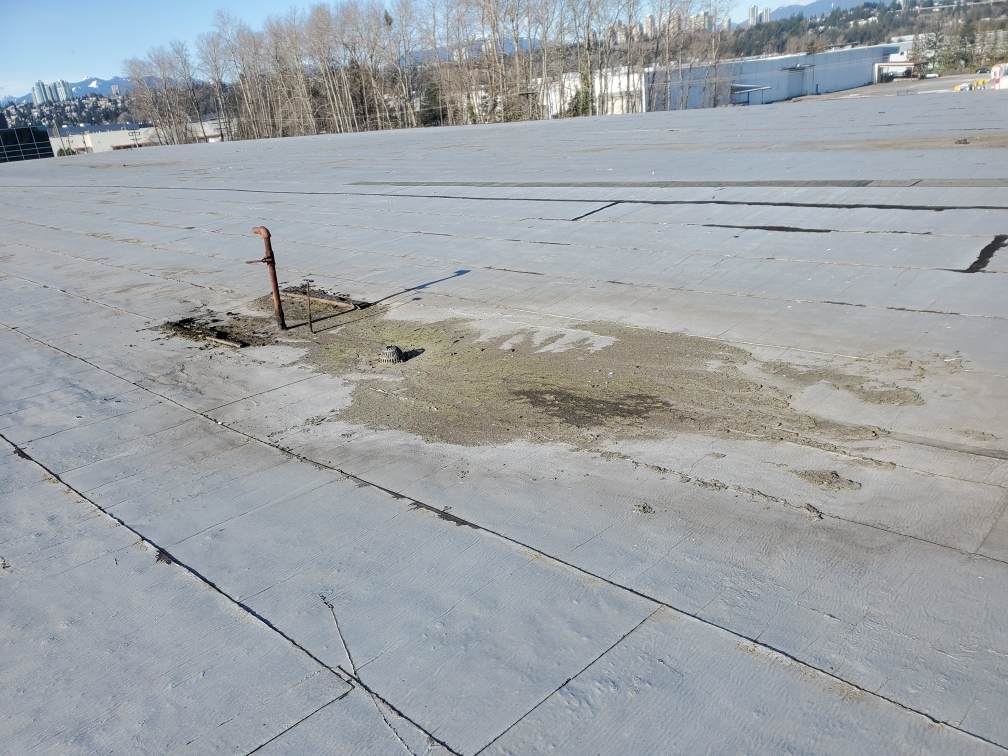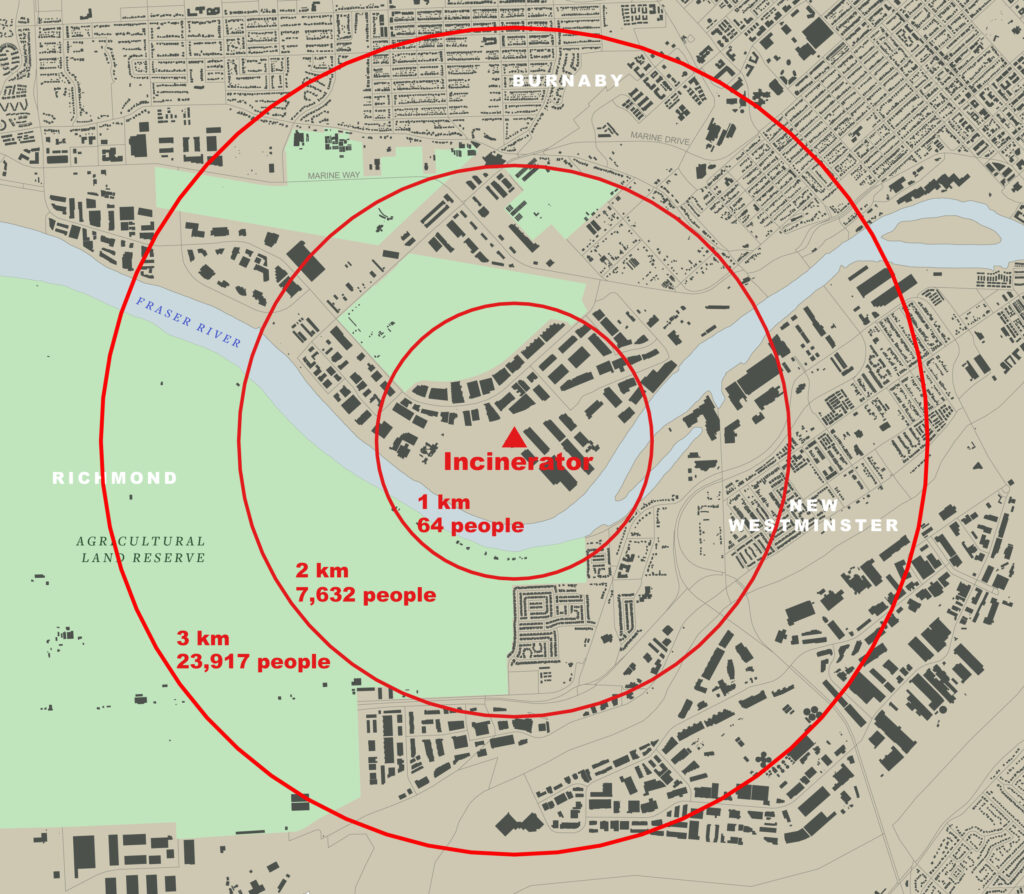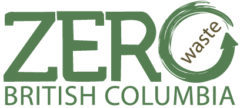Health Alarm: Toxic Dioxins and Heavy Metals Detected Near Metro Vancouver Incinerator
Vancouver, B.C. (July 7, 2025) — Independent testing has revealed dangerous levels of dioxins, furans, and heavy metals in dust collected from a rooftop within 500 metres of Metro Vancouver’s waste incinerator in Burnaby, raising serious health concerns for nearby communities.
The test results showed a toxic equivalency of 44 picograms per gram of dioxins and furans in the dust, a significant health risk considering Health Canada’s tolerable daily intake (TDI) is just 2.3 picograms per kilogram of body weight. This means children playing in contaminated areas could face dangerous exposure levels, above the Health Canada limit.
“Dioxins are a huge concern as they concentrate in people as exposure increases and represent a risk, especially to babies and children,” said Dr. Douglas Courtemanche of Doctors for Planetary Health – West Coast. “Dioxins are potent carcinogens and endocrine disruptors that have an adverse effect on neurological and reproductive development in the early stages of life and have dangerous hormonal and reproductive effects in adults.”
For years, landowners near the Metro Vancouver incinerator have reported substantial material deposits from the air accumulating on their properties, requiring annual cleaning. Independent test results mirror similar findings around incinerators in the European Union, where higher-than-expected pollution levels have been discovered through independent testing.
Dr. Tim Takaro, a physician-scientist with the Canadian Association of Physicians for the Environment who specializes in chemical exposures, expressed concerns: “Metro Vancouver has said that the waste-to-energy facility is designed to prevent dioxins and furans from entering the environment and that incinerators ‘do not create a health risk to the public or people working in the vicinity.’ However, THIS incinerator is clearly a source of hazardous pollutants in an already polluted airshed. An independent assessment is needed—now.”
Metro Vancouver is only required to test for dioxins and furans on one of the facility’s three boilers once a year, under ideal conditions (i.e. not during start up, shut down or malfunction) and at a time of their choosing. Meanwhile, many homes, schools, and farms lie within a two-kilometer radius of the incinerator. These communities already face high levels of air pollution, given the lower Fraser Valley’s overall poor air quality, with New Westminster recording the worst nitrogen dioxide levels in the province according to a BC Lung Association report. The incinerator therefore adds to this dangerous air pollutant burden.
“It should not take citizens testing rooftop debris themselves to confirm what frontline communities have been saying for decades,” said Denaya Shorter, Senior Director of the US/Canada Region at the Global Alliance for Incinerator Alternatives (GAIA). “Incinerators are toxic, expensive, and harmful to both people and the environment. We cannot allow families, especially children, to carry the burden of Metro Vancouver’s outdated and dangerous waste system.”
The BC Government is responsible for setting emissions limits and issuing a permit to operate and recently amended Metro Vancouver’s operational certificate, extending the deadline to reduce acid gases (hydrochloric acid and sulphur dioxide) from 2025 to 2028. Despite being granted this seven year time frame from the original 2021 permit, Metro Vancouver is appealing the decision. The permit also fails to require continuous testing for heavy metals and dioxins/furans, unlike more stringent standards in places like Oregon.
In addition to the facilities’ health risks, there are significant financial concerns associated with the project. Zero Waste BC’s review of Metro Vancouver’s documents show the incinerator is the costliest waste management option (compared to zero waste actions or even landfilling), with higher greenhouse gas emissions per tonne of waste and per unit of energy than alternatives. In March, Metro Vancouver signed a $245 million agreement to operate the facility for 5 years (equivalent to $196 per tonne), with additional capital maintenance expenses of almost $80 million, $217 million on district energy, and $100 million for acid gas reduction.
“With Metro Vancouver looking to save money and under fire for significant cost overruns on liquid waste projects, investing over $400 million more in a worn-out incinerator past its service life, with the high risk of even more cost escalations, seems foolhardy,” said Jamie Kaminski of Zero Waste Canada.
Sue Maxwell of Zero Waste BC noted, “Despite Metro Vancouver’s stated priority of ‘waste reduction and recycling’ in a March 6, 2025 interview, evidence shows that more emphasis has been placed on maintaining the 37-year-old incinerator.”
The Canadian Association of Physicians for the Environment BC, Doctors for Planetary Health – West Coast, the Global Alliance for Incinerator Alternatives (GAIA), For Our Kids – Burnaby, Force of Nature Alliance -Burnaby, West Coast Climate Action Network, Zero Waste BC and Zero Waste Canada are calling for:
- A comprehensive study conducted by an independent health organization on the levels and cumulative impacts of pollution from the incinerator, with full transparency on process and results; and
- Halting further work on connecting the incinerator to a district energy system until the facility is proven to be cost-effective and safe for the community and environment.
Signatories
CAPE-BC – Dr. Tim Takaro
Doctors for Planetary Health – West Coast – Dr. Douglas Courtemanche
Zero Waste BC – Sue Maxwell
Zero Waste Canada – Jamie Kaminski
Force of Nature Alliance – Burnaby – Sunil Singal
For Our Kids – Burnaby – Kate McMahon
West Coast Climate Action Network-Tara Shushtarian
GAIA – Denaya Shorter
For background info and supporting documents, please see here.


UPDATE to July 7, 2025 Media Release July 30, 2025
Re: Metro Vancouver Response
Following the release of our July 7, 2025 statement regarding the detection of dioxins and heavy metals near the Waste-to-Energy Facility, Metro Vancouver has raised objections to several of the claims made. They assert that there is no evidence that the rooftop dust sampled originated from the facility, that dioxin and furan emissions remain well below regulatory thresholds, that the facility poses no health risk to the public, that incineration is the most cost-effective option for waste management, and that waste prevention is a core priority of their strategy.
While we appreciate Metro Vancouver’s engagement on this issue, we remain concerned about the public health implications of detecting dioxins at the concentrations we found in our single sample, regardless of the source. The presence of these compounds in the local environment warrants serious attention and precautionary action. Further, research from other jurisdictions demonstrates that dioxins are often found near incinerators, despite incinerators meeting local standards.
We continue to call for a comprehensive, independent testing regime led by a public health authority and funded by Metro Vancouver, with full transparency in both methodology and results.
We are currently in discussions with Metro Vancouver and will be meeting with their staff and representatives in August. We will provide a further public statement following that meeting to update the community on next steps and any new information shared.
Zero Waste BC, CAPE, Zero Waste Canada, Doctors for Planetary Health -West Coast, Force of Nature -Burnaby, For Our Kids -Burnaby, West Coast Climate Action Network and GAIA.
